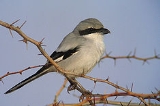
Southern Grey Shrike
Encyclopedia
The Southern Grey Shrike, Lanius meridionalis, is a member of the shrike
family.
It is closely related to the Great Grey Shrike
, Lanius excubitor, with which it used to be considered conspecific; where they co-occur, they do not interbreed and are separated by choice of habitat
.
The race L. m. meridionalis is resident in southern Europe
and north Africa
. It is slightly smaller and darker than the Great Grey Shrike, and prefers dry open country.
The race L. m. pallidirostis breeds in central Asia
and winters in the tropics. It is much paler than Southern Grey or Great Grey, and is sometimes split as a separate species, the Steppe Grey Shrike, L. pallidirostis. It too prefers more arid habitat with sparse vegetation.
This medium-sized passerine
bird
eats large insects, small birds and rodents. Like other shrikes it hunts from prominent perches, and impales corpses on thorns or barbed wire as a "larder".
The plumage is generally similar to Great Grey Shrike apart from the differences noted above.
The migratory
eastern form is a scarce vagrant to western Europe
, including Great Britain
, usually in autumn.
Shrike
Shrikes are passerine birds of the family Laniidae. The family is composed of thirty-one species in three genera. The family name, and that of the largest genus, Lanius, is derived from the Latin word for "butcher", and some shrikes were also known as "butcher birds" because of their feeding habits...
family.
It is closely related to the Great Grey Shrike
Great Grey Shrike
The Great Grey Shrike or Northern Grey Shrike is a large songbird species in the shrike family . It forms a superspecies with its parapatric southern relatives, the Southern Grey Shrike , the Chinese Grey Shrike and the Loggerhead Shrike...
, Lanius excubitor, with which it used to be considered conspecific; where they co-occur, they do not interbreed and are separated by choice of habitat
Habitat (ecology)
A habitat is an ecological or environmental area that is inhabited by a particular species of animal, plant or other type of organism...
.
The race L. m. meridionalis is resident in southern Europe
Europe
Europe is, by convention, one of the world's seven continents. Comprising the westernmost peninsula of Eurasia, Europe is generally 'divided' from Asia to its east by the watershed divides of the Ural and Caucasus Mountains, the Ural River, the Caspian and Black Seas, and the waterways connecting...
and north Africa
Africa
Africa is the world's second largest and second most populous continent, after Asia. At about 30.2 million km² including adjacent islands, it covers 6% of the Earth's total surface area and 20.4% of the total land area...
. It is slightly smaller and darker than the Great Grey Shrike, and prefers dry open country.
The race L. m. pallidirostis breeds in central Asia
Asia
Asia is the world's largest and most populous continent, located primarily in the eastern and northern hemispheres. It covers 8.7% of the Earth's total surface area and with approximately 3.879 billion people, it hosts 60% of the world's current human population...
and winters in the tropics. It is much paler than Southern Grey or Great Grey, and is sometimes split as a separate species, the Steppe Grey Shrike, L. pallidirostis. It too prefers more arid habitat with sparse vegetation.
This medium-sized passerine
Passerine
A passerine is a bird of the order Passeriformes, which includes more than half of all bird species. Sometimes known as perching birds or, less accurately, as songbirds, the passerines form one of the most diverse terrestrial vertebrate orders: with over 5,000 identified species, it has roughly...
bird
Bird
Birds are feathered, winged, bipedal, endothermic , egg-laying, vertebrate animals. Around 10,000 living species and 188 families makes them the most speciose class of tetrapod vertebrates. They inhabit ecosystems across the globe, from the Arctic to the Antarctic. Extant birds range in size from...
eats large insects, small birds and rodents. Like other shrikes it hunts from prominent perches, and impales corpses on thorns or barbed wire as a "larder".
The plumage is generally similar to Great Grey Shrike apart from the differences noted above.
The migratory
Bird migration
Bird migration is the regular seasonal journey undertaken by many species of birds. Bird movements include those made in response to changes in food availability, habitat or weather. Sometimes, journeys are not termed "true migration" because they are irregular or in only one direction...
eastern form is a scarce vagrant to western Europe
Europe
Europe is, by convention, one of the world's seven continents. Comprising the westernmost peninsula of Eurasia, Europe is generally 'divided' from Asia to its east by the watershed divides of the Ural and Caucasus Mountains, the Ural River, the Caspian and Black Seas, and the waterways connecting...
, including Great Britain
Great Britain
Great Britain or Britain is an island situated to the northwest of Continental Europe. It is the ninth largest island in the world, and the largest European island, as well as the largest of the British Isles...
, usually in autumn.
Identification
- Jorma Tenovuo & Juha Varrela (1998) Identification of the Great Grey Shrike complex in Europe AlulaAlula (journal)Alula was an ornithological magazine published in Finland. Initially it was published in both Finnish and English, but the final volumes were published in English only. It was aimed primarily at birders with an interest in the birds of the Western Palearctic...
4(1): 4 - 11
- Clement, Peter, and Tim Worfolk (1995) Southern and eastern Great Grey Shrikes in northwest Europe Birding WorldBirding WorldBirding World is a monthly birding magazine published in the United Kingdom. It is the magazine of the Bird Information Service, based at Cley next the Sea, Norfolk....
8(8) 300-309

